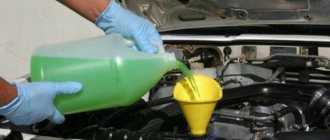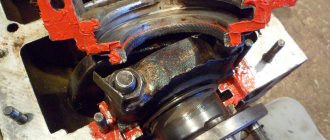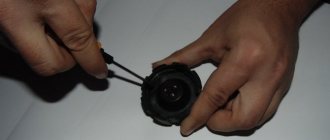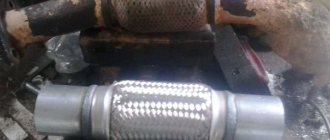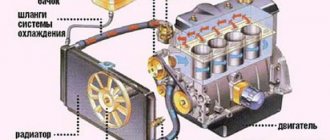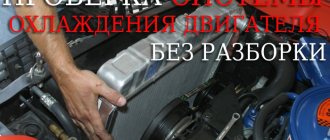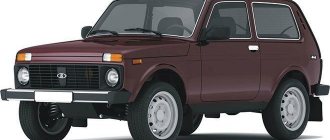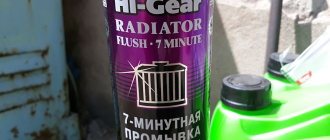Flushing the machine's engine cooling system from dirt, oil emulsion or rust should be carried out at least once a year. To carry out the procedure, both folk remedies are used, for example, vinegar or citric acid, and compositions specially designed for this. The cleaning principle is always the same: first, liquid is poured into the expansion tank, after which the engine warms up. At the final stage, the product is drained from the SOD and replaced with new antifreeze.
Why is it necessary to flush the engine cooling system?
The procedure is considered necessary, along with changing filters and oil. Flushing the cooling system does not seem as important as other car care procedures. In fact, the cooling system can cause a lot of trouble if it becomes clogged with dirt. Therefore, it must be washed periodically. If you neglect this, then blockages and scale will clog the radiator, pump, and pipes. It is convenient to carry out washing along with replacement. The condition of the antifreeze determines how dirty the cooling system is. If it drains quite clean, then minimal washing is done. If it has darkened, there are inclusions and flakes in it, then thoroughly rinse the system. Whether it is worth visiting a service station or doing everything yourself is a matter for the car owner to decide for himself. The optimal solution is to send the car to the station. The technicians will clean it quickly, but you will have to part with the car for a while. You can also wash the part at home.
How often to wash
Manufacturers do not indicate exact timing for such an operation. Experts recommend cleaning the engine cooling system every time the antifreeze is replaced. It is usually changed after 3-5 years or after 90-150 thousand kilometers. The scheduled period for replacing antifreeze can be found on the Internet.
Experts believe that an uncontrolled radiator flushing procedure can harm the car. At the same time, timely maintenance cannot eliminate possible problems with the cooling system. Replacing antifreeze and cleaning the system should be carried out every few years. This will help prevent breakdowns.
It is necessary to flush the engine cooling system in the following cases:
- If the engine systems were repaired and dirt got inside.
- If antifreeze was added a long time ago.
There is no need to wash the car if the car was purchased from an authorized dealer at a car showroom. It is also not required if the antifreeze was always changed on time and low-quality liquid was not added to the system.
What to rinse with or how to choose a rinse
There are folk and special means for flushing the engine cooling system , which we will discuss later.
This procedure must be done outside during the warm season. In winter you will need to go into a warm box. The gentlest cleaning method involves using ordinary water. If there is heavy scale, water will not remove it. In this case, it is necessary to use special cleaning agents. These can be brands such as Lavr, Radiator, Flush, etc. To remove limescale, you can take:
- vinegar,
- soda,
- citric/lactic acid and other folk remedies.
You should not use Cola as a cleaner. It is not intended for this and can destroy the internal surfaces of the radiator.
The choice of substance for flushing the radiator depends on factors:
- Mileage. The new engine does not require aggressive agents, since there are no deposits in it. In this option, you need to take neutral substances or folk remedies. The old unit can be washed with effective two-component products.
- Engine's type. The products for cars and trucks are different. There are also universal substances applicable to any type of transport.
- Antifreeze used. Flushing must be compatible with it.
How to flush the engine cooling system from rust
You can clean the radiator parts from dirt and rust using a solution of regular citric acid. Flushing a car's cooling system is very simple. First, make a solution: take about 30 grams of acid per liter of clean water. In case of severe rust, the concentration of the active substance can be increased to 100 grams. Next, drain the old liquid and pour in a fresh solution. The engine is warmed up and the liquid is left for several hours. After this, it is drained and the condition is assessed. If the solution is dirty, repeat the procedure several more times. The final stage is flushing the system with plain water and further filling with coolant.
Using the same scheme, you can clean the radiator with acetic acid. The solution is prepared in the following proportion: take 500 ml of vinegar per 10 liters of water. The procedure is carried out similarly to that described above.
Flush the engine cooling system of oil
In a working car, oil does not mix with antifreeze. Oil may get into the coolant due to a breakdown. Then it is necessary to flush the radiator. If you do not do this, other parts of the machine will suffer: the diesel engine, bearings, etc. You can flush the cooling system of oil using folk remedies: whey, Coca-Cola, citric acid, Fairy for dishes. The radiator is also cleaned with distilled water. At the same time, it is washed several times. Special formulations effectively combat this problem. The professional drug ABRO AB-505 has good reviews. It is used against oil stains, rust and scale. There are other excellent products that are sold in car dealerships and service stations.
Using available means in the form of, for example, Coca-Cola, you cannot be sure of the quality of the treatment. Carbonated drinks contain phosphoric acid, which easily damages car pipes. According to experts, even cleaning with professional compounds does not completely eliminate the oil film. It is possible to wash out stubborn dirt and oil only after unsoldering the tank.
Choice of drug
Before purchasing a flushing agent, you need to determine the predominant nature of the coolant contamination. When inorganic components predominate (scale, products of corrosion and oxidation of metals), a white precipitate with a hint of rust is observed under the cap of the radiator tank or conservator. For this case, choose an acid-containing cleaner based on orthophosphoric acid or its phosphates.
Organic contaminants (antifreeze decomposition products, oil, dirt) give the antifreeze a cloudy color. To remove them, you must use an alkaline detergent. Along with the main elements: surfactants, pH acid-base balance regulator, the preparation must contain complexing additives that promote intensive dissolution and removal of dirt residues.
It is good when the composition contains anti-corrosion inhibitors that protect parts made of metal. Finally, for water-based washes, deionized water should be used and the packaging should indicate this. Regular water contains salts that cause limescale formations.
Tip: when choosing a specific product for flushing the cooling system, consider the condition of the radiator, other devices and the fluid to be replaced.
Lemon acid
The substance is capable of removing rust, since it contains acid . The working solution can be prepared as follows:
For 1 liter of ordinary water, take 2 tablespoons of acid if prevention or light cleaning is planned. If the part has not been washed for a long time, then take 10 tbsp per liter of water. spoons of substance. The water must have high acidity.
Algorithm of actions:
- The cooling system is drained of liquid.
- Pour in prepared water with acid.
- Start the engine, heat it up and leave it for a couple of hours.
- Drain the liquid. If it is cloudy, repeat the procedure.
- Rinse the system with plain water.
Video of flushing the cooling system with citric acid
To know exactly how to flush the radiator , watch the video on the Internet. This will help you flush the unit yourself. Citric acid is considered a good cheap remedy. Users recommend buying it not in bags, but by weight. It is recommended to take distilled water. Flushing the system with acid is easy and simple.
How to flush a cooling radiator with acetic acid
Vinegar is considered an effective and affordable system cleaner. For the procedure, take 1 bottle of vinegar and approximately 10 liters of water. Vinegar is diluted in water to obtain a 3% solution. It is poured into the cooling system. Next, start the engine, warming it up to operating temperature. After the fan automatically turns on, the engine is turned off. After this, the solution is drained. The engine cooling radiator can be additionally washed with soda solution.
How to flush the cooling system with lactic acid or whey
Cleaning the engine cooling system with whey is a gentle and longest-lasting method. After draining the old coolant, add filtered whey or lactic acid. Then we drive about 50 km by car. After this, the liquid is drained and the system is washed with clean water.
Do-it-yourself flushing of the engine cooling system using caustic soda
You can clean the radiator from dirt with caustic soda. This method is not used if the engine contains aluminum. Otherwise, such soda will react with it. This will cause motor damage. If you know for sure that there is no aluminum, you can wash the cooling system like this:
- Remove coolant.
- Prepare a working solution at the rate of 300 grams of caustic soda per 5 liters of water.
- Start the car.
- Leave the soda solution for 5 hours.
- Drain the liquid.
Caustic soda has a second hazard class. The hand must be gloved, otherwise the substance may corrode the skin. It is also recommended to use safety glasses when working.
Cleaning the cooling system with Fanta
Fanta drink is successfully used by car owners to clean radiators. It contains citric acid, which explains the cleansing effect. The duration of the procedure depends on how dirty the system is. Preventive cleaning consists of the fact that after pouring the forfeit inside, the engine is allowed to idle for about 40 minutes. To wash away old dirt, you need to drive a car for 2 days. Next, the used liquid is drained and the system is washed with distillate. After this, it is also drained and the part is washed with water. The clean system is filled with fresh antifreeze.
Preparing for work
For washing you can use:
- distilled water,
- acidified water,
- special means, the choice of which is quite wide.
The work should be done either in the warm season, or, if it is winter, then in a warm garage.
The first thing to do is to place the car on a relatively horizontal surface. If the engine has just been turned off, then you need to wait until it cools down, that is, it is only warm.
But it is still better to work with gloves, since the liquid in the system will be much warmer than the surface of the engine.
You need to install a container under the motor, the volume of which is no less than the liquid in the system. Then, using a key, unscrew the plug on the cylinder block and the one in the lower radiator tank.
Professional products for cleaning the engine cooling system
Special formulations are highly effective. They are distinguished depending on their composition:
- Neutral. Used for prophylactic purposes. They do not contain aggressive components. They are characterized by minimal efficiency.
- Acidic. Designed to eliminate inorganic contaminants. They have aggressive substances, due to which they act quickly.
- Alkaline. Dissolves organic compounds.
- Two-component. Contains acids and alkalis. These are the most effective means. But they have a high cost.
use two compounds at the same time to clean the cooling system . It is also not recommended to fill it with highly concentrated liquids. Otherwise, the engine may be damaged.
Flushing the cooling system Lavr radiator flush classic
This is a professional product that can be purchased at a specialized store. The composition is suitable for engines of any type. It is also used for construction equipment. This product, like gear radiator flush 7 minute, is poured into the system before changing the cooling antifreeze. Rinsing quickly and effectively removes heavy contamination. Using the drug, oil, rust, scale, etc. are removed. By using such a substance, you can increase the period of use of antifreeze.
Lavr radiator flush is sold in 1 liter containers. It is characterized by an affordable price and high activity. It contains alkalis and acids. The product is produced by a Russian enterprise, so it is ideal for use in local conditions. Flushing the engine cooling radiator is easy. First you need to cool the engine and drain the coolant. Shake the working substance and pour it inside. Next, turn the engine on at idle speed. After using the product, the system is washed and new antifreeze is added.
Cleaning the cooling system using Hi gear radiator flush 7 minute
This is an American made cleaning It is actively used by car owners in Russia, Europe and the CIS. Its advantages are affordable price and high efficiency. The advantage is considered to be the application time - only seven minutes. After a short treatment, the reagent can be removed from the system. After this, the performance of the coolant increases. Contains only alkali. Therefore, gear radiator flush 7 minute is not used for cleaning in every case, but only to eliminate organic formations. The product is well compatible with any surfaces. Cleaning the radiator is very quick with it.
How to flush an engine cooling system with liqui moly kuhler reiniger
A popular and affordable engine flushing tool. It is used in any cooling systems. It contains no components that can corrode parts. Usually this liquid is taken for prophylaxis. Liqui moly kuhler reiniger is recommended to be used a couple of times a year to prevent the formation of scale and other substances. One 300 ml can holds 10 liters of water. After pouring the product into the system, the car is left to idle. After cleaning the engine cooling system, add fresh antifreeze. This substance is not used for difficult stains.
Cleaning the cooling system with Xenum m flush
This is a high quality cleaning solution for stubborn stains. The substance is suitable for use in diesel and gasoline engines. It is sold at a high price, but the high cost is justified: the product is suitable for old units that have persistent and severe contamination. Xenum m flush is able to restore the functions of piston rings and hydraulics. The substance improves engine performance and reduces the cost of operating a vehicle. After this, working fluids can be used longer.
Cooling system flushing fluid Zic flush
Korean product for cleaning passenger car engines. It is sold in 4 liter containers, so it is designed for long-term use. It is permissible to use it for flushing not only the engine, but also other components. It quickly and effectively removes scale, rust, and oil traces. The liquid is completely safe for polymer materials. If you use Zic flush correctly, you can extend the life of the main components of the machine. The downside is the high cost.
Wynns w76695 injection system purge
The product helps to effectively flush the engine cooling system. It is applicable for cars with high mileage that are heavily soiled. To do this, you do not need to disassemble the unit. Flushing the system helps improve its performance. Wynns w76695 injection system purge is produced in Belgium. The product has a volume of 1 liter and is suitable only for injection-type engines.
Tips and tricks
General principles, recommendations and features of the cleaning procedure at home:
- When performing the task, you cannot use ordinary running water. This liquid contains trace elements that contribute to the formation of rust on metal parts of the cooling system, in particular the radiator. This leads to faster wear of the device.
- You cannot use antifreeze or antifreeze purchased from unlicensed sellers. Such products can often not be manufactured in accordance with GOST, as a result of which their service life is significantly lower. In addition, such liquids precipitate faster and clog the elements of the cooling system.
- The coolant must be replaced every 2-3 years, depending on the standard of the consumables used. On average, the service life of the refrigerant is about 40-80 thousand kilometers.
- Flushing must be performed before replacing the refrigerant.
Safety precautions:
- If the vehicle's power unit is warmed up to operating temperature, it must be allowed to cool before flushing. Contact of hot antifreeze on the skin will cause a burn.
- When replacing or cleaning the cooling system, the vehicle must be on a level, level surface.
- The user must wear gloves when performing the task. This will protect your hands from hot elements of the power unit.
- When draining consumables, the corresponding plug opens. You need to use a wrench, as boiling water will cause burns.
What is not recommended for flushing the cooling system?
There are folk remedies that are ineffective and harmful to car parts. Among them is water used by car owners for cleaning. In warm weather, plain water promotes rapid scale formation. In winter, its action can result in icing, which is followed by the failure of many units. It is acceptable to use filtered and boiled water, since they contain less salts and other particles. But this method is considered ineffective. Let's look at other compounds that should not be used.
Coca Cola
Soda in the form of Coca-Cola contains phosphoric acid. It corrodes plaque and corrosive formations well. Together with them, it spoils the coating of the machine elements. Cola contains large amounts of carbon dioxide and sugar. These components can cause some problems in the engine. If you decide to cleanse with this drink, you must first remove the carbon dioxide from it. After the procedure, the system must be thoroughly rinsed with water to remove any remaining sugar. You should also remember that Coca-Cola can be kept in the system for a maximum of 10 minutes.
Fairy
This detergent is excellent at removing dirt and grease. It is not intended to combat motor oil. Its downside is that it foams a lot. When using, it is necessary to monitor the condition of the expansion tank. After flushing the engine cooling system, you have to rinse the engine with water for a long time to remove Fairy residue.
Calgon and its analogues
The purpose of such products is to clean water pipes from lime deposits. They are not recommended for use in automobiles.
White
Contains sodium hypochlorite. This substance reacts with aluminum and corrodes it. Corrosion occurs very quickly at high temperatures. Therefore, “Belizna” cannot be poured into the cooling system, just like other products with bleach.
Mole
The liquid contains caustic soda. It is not suitable for cleaning aluminum parts. "Mole" can only be used for copper units.
Other mixtures
There are folk remedies for cleaning that have a detrimental effect on car parts. For example, a mixture of soda, citric acid and vinegar. It corrodes rubber and plastic parts. It is much safer and more effective to use a special cleaning product from the range of auto chemicals.
Rules for draining old antifreeze
You need to learn a few rules for filling and draining coolant.
- Antifreeze is added and drained only after the engine has completely cooled down.
- Before washing, check the cap of the expansion tank. It must be open.
- Safety rules must be followed. Since additives are caustic chemicals, work with them only with rubber gloves to avoid damaging the skin of your hands.
How to wash the outside of a car radiator
The cooling radiator is actively used. During operation, it becomes clogged with dirt and debris. Then the heat does not completely escape into the environment, but flows back to the engine. As a result, the motor overheats. The radiator must be cleaned regularly to keep the vehicle in good working order. To clean the outside of the unit, you can use ordinary water. If there is persistent contamination, then water alone will not be enough. Then it is better to take a special substance to clean the outside of the car radiator. There are many universal products on sale that are good at cleaning dirt from the unit. The cost of such substances varies. It depends on the composition and manufacturer.
Auto chemicals contain concentrated components that quickly remove salt deposits, rust, oil stains, and dirt. For external cleaning you will need buckets, brushes, work gloves, rags, and cleaning agent. To wash the outside of the radiator, you must first remove it from under the hood. You can perform the procedure using soapy water and a brush. This is the easiest way to clean the radiator externally. After soaping the knot, it is washed with warm water.
How to flush a cooling radiator
Manufacturers produce effective products for flushing the radiator from the outside. The following substances have good reviews:
- Liqui Moly Kuhler Reiniger. An excellent product for removing scale, dirt with grease particles and chemical compounds.
- Hi-Gear. Designed for old dirt and rust.
- Mannol - External cleaning of the unit removes rust, scale and other deposits.
If external cleaning does not bring results, you will need to perform internal flushing. If there is serious damage, the unit will need to be replaced. In many cases, mechanical cleansing is successfully carried out independently. This solves the problem of overheating. At the same time, they inspect the pipes and hoses, change the radiator cap and thermostat.
Caustic soda
This substance is popularly called differently - sodium hydroxide, “caustic alkali”, “caustic soda”, “caustic” and so on.
The substance can only be used to clean copper radiators (including stove radiators). You cannot clean aluminum surfaces with baking soda.
In accordance with the official instructions of the manufacturer of copper radiators, it is necessary to act according to the following algorithm:
Caustic soda
- remove the radiator from the car;
- rinse its insides with plain water and blow with compressed air (not exceeding a pressure of 1 kgf/cm2) until clean water flows out of the radiator;
- prepare about 1 liter of 10% caustic soda solution;
- heat the composition to at least +90°C;
- pour the prepared mixture into the radiator;
- let it brew for 30 minutes;
- drain the solution;
- for 40 minutes, rinse the insides of the radiator with hot water and blow with hot air alternately (the pressure should not exceed 1 kgf/cm2) in the opposite direction to the direction of pump operation .
Remember that caustic soda causes burns and corrodes living tissue. Therefore, it is necessary to work outdoors wearing gloves and a respirator.
As a result of the chemical reaction, white foam may appear from the radiator pipes. If this happens, do not be alarmed, this is normal. The tightness of the cooling system after cleaning must be carried out on a cold engine, since hot water quickly evaporates, and finding the suspected leak location will be problematic.
